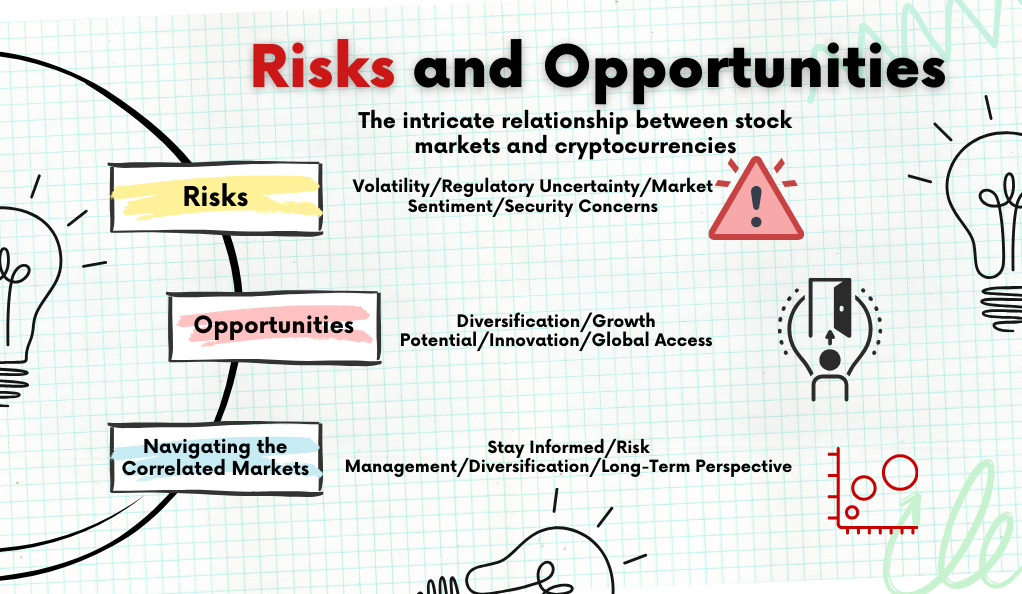In the ever-evolving landscape of finance, two major players have emerged as pivotal forces shaping the way we invest and perceive value: stock markets and cryptocurrencies. The stock market, with its centuries-old history, has been the traditional powerhouse of investment, offering a platform for buying and selling shares of publicly traded companies. On the other hand, cryptocurrencies, a product of the 21st century, have introduced a revolutionary digital alternative to traditional currencies, challenging the very fabric of financial transactions.
The stock market has long been a reflection of a country’s economic health, with indices like the S&P 500, Dow Jones Industrial Average, and NASDAQ serving as barometers for the U.S. economy. Companies listed on these exchanges are subject to stringent regulations, providing a level of transparency and security for investors. In contrast, the world of cryptocurrencies is relatively unregulated, offering a decentralized approach to currency and investment. Bitcoin, Ethereum, and other major cryptocurrencies have paved the way for this new era, creating a market that is both volatile and intriguing.
As these two worlds collide, a growing interest has emerged in understanding the correlation between stock markets and cryptocurrencies. Are they independent entities operating in their own silos, or is there a hidden thread that binds them together? This article aims to delve deep into this relationship, exploring the historical context, the factors influencing their correlation, and what it all means for the modern investor.
The journey of understanding this intricate relationship begins with a look at the basics of both stock markets and cryptocurrencies, setting the stage for a comprehensive exploration of their correlation, the risks and opportunities it presents, and the future outlook of these two financial giants.
Basics of Stock Markets and Cryptocurrencies

Stock Markets: The Traditional Investment Platform
The stock market is a complex system where shares of publicly traded companies are bought and sold. It serves as a crucial component of a healthy economy, providing companies with access to capital in exchange for giving investors a slice of ownership in the business. Major stock exchanges around the world, such as the New York Stock Exchange (NYSE) and the London Stock Exchange (LSE), host the trading activities, ensuring transparency and regulation.
Investors in the stock market range from individuals looking to secure their financial future to institutional investors managing vast portfolios. The market is influenced by a myriad of factors including economic indicators, company performance, and global events, making it a dynamic and sometimes unpredictable environment.
Cryptocurrencies: The Digital Frontier of Finance
Cryptocurrencies, on the other hand, represent a paradigm shift in how we think about money and assets. Originating with Bitcoin in 2009, the cryptocurrency market has grown exponentially, now encompassing thousands of different digital currencies. Unlike traditional currencies, cryptocurrencies operate on blockchain technology, ensuring decentralization and transparency.
The cryptocurrency market is known for its volatility, with prices capable of significant fluctuations within short periods. This has attracted a wave of investors looking to capitalize on these price movements, as well as those who believe in the long-term potential of blockchain technology.
Key Differences and Similarities
While stock markets and cryptocurrencies are fundamentally different, they also share some similarities. Both markets are driven by supply and demand dynamics, and both offer opportunities for investment and wealth creation. However, the stock market is generally considered to be more stable and regulated, whereas the cryptocurrency market is newer, more volatile, and operates with less oversight.
The table below summarizes the key differences and similarities between stock markets and cryptocurrencies:
| Aspect | Stock Markets | Cryptocurrencies |
|---|---|---|
| Regulation | Highly regulated | Less regulated |
| Stability | Generally stable | Highly volatile |
| Accessibility | Requires a brokerage account | Accessible to anyone with an internet connection |
| Trading Hours | Set trading hours (with some after-hours trading) | 24/7 |
| Underlying Asset | Represents ownership in a company | May not represent ownership in a tangible asset |
| Dividends | Some stocks pay dividends | Few cryptocurrencies offer dividend-like rewards |
| History | Centuries-old | Just over a decade old |
Historical Correlation and Trends
The relationship between stock markets and cryptocurrencies has been a subject of intense scrutiny and debate. To understand this correlation, it is crucial to delve into historical trends and events that have shaped the interaction between these two financial realms.
- Analyzing Past Trends
Historically, the stock market and cryptocurrencies have shown a low correlation, meaning that the movements in one market do not necessarily predict or influence the movements in the other. However, there have been instances where both markets have reacted similarly to global economic events, suggesting that there might be underlying factors that link them.
For example, during significant market downturns, such as the financial crisis of 2008 or the COVID-19 pandemic in 2020, both stock markets and cryptocurrencies experienced volatility. Investors tend to flock to safer assets in times of uncertainty, which can lead to sell-offs in both markets.
- Case Studies: Specific Events Impacting Both Markets
- The COVID-19 Pandemic: The pandemic serves as a recent example where both markets were impacted. Initially, both stock markets and cryptocurrencies experienced sharp declines as the world grappled with the uncertainty of the virus. However, they both rebounded strongly in the months that followed, fueled by government stimulus packages and a surge in retail investing.
- Regulatory Announcements: Announcements of potential regulations or bans on cryptocurrencies by various countries have led to immediate impacts on cryptocurrency prices, and at times, have also influenced stock markets, particularly stocks of companies involved in blockchain technology or cryptocurrency trading.
- Visual Representation of Correlation
To better understand the correlation, let’s look at a hypothetical graph showing the price movements of a major stock index and a major cryptocurrency over a specific period:

Factors Influencing the Correlation
Understanding the correlation between stock markets and cryptocurrencies requires an examination of the various factors that influence both. These factors can range from macroeconomic conditions to investor behavior, and they play a crucial role in shaping the relationship between these two financial realms.
1. Macroeconomic Factors:
- Economic Stability: The overall stability of the global economy can have a significant impact on both stock markets and cryptocurrencies. In times of economic prosperity, investors may be more willing to take risks, leading to bullish trends in both markets. Conversely, economic downturns can result in bearish trends.
- Inflation and Interest Rates: Changes in inflation rates and interest rates set by central banks can influence investor confidence and behavior. For example, higher interest rates may make traditional investments more attractive, potentially leading to a decrease in cryptocurrency investments.
2. Investor Sentiment and Behavior:
- Risk Appetite: The willingness of investors to take on risk can influence both markets. Cryptocurrencies are often considered high-risk, high-reward investments, while stocks are generally viewed as more stable. Changes in risk appetite can lead to shifts in investment between the two.
- Speculation: Both markets are susceptible to speculative trading, where investors make decisions based on short-term price movements rather than fundamental value. This can lead to increased volatility.
3. Regulatory Changes and Government Policies:
- Regulation: The level of regulation in the cryptocurrency market is a significant factor. Announcements of increased regulation, or the potential for regulation, can lead to price volatility. Similarly, stocks of companies involved in cryptocurrencies can be affected.
- Government Policies: Policies related to financial markets, technology, and cryptocurrencies can influence investor confidence and market stability. For example, a government’s stance on cryptocurrency adoption can impact the market’s perception of its long-term viability.
4. Technological Developments:
- Innovation: Advances in blockchain technology and the introduction of new financial products related to cryptocurrencies can influence both markets. For example, the introduction of Bitcoin futures trading had implications for both cryptocurrency and traditional financial markets.
- Security: The security of cryptocurrency exchanges and wallets is a constant concern. High-profile hacks and security breaches can lead to loss of investor confidence and market volatility.
Risks and Opportunities

The intricate relationship between stock markets and cryptocurrencies brings forth a spectrum of risks and opportunities for investors. Navigating this landscape requires a balanced understanding of the potential pitfalls and the promising prospects that lie within.
Risks:
- Volatility: Cryptocurrencies are notorious for their price volatility, with values that can skyrocket or plummet within short time frames. This volatility can sometimes spill over into the stock markets, especially for stocks related to blockchain and cryptocurrency.
- Regulatory Uncertainty: The lack of comprehensive regulation in the cryptocurrency market poses risks. Potential future regulations can lead to abrupt market changes, affecting both cryptocurrencies and related stocks.
- Market Sentiment: Both markets are influenced by investor sentiment, which can be fickle. Negative news or social media trends can lead to rapid sell-offs, while positive news can lead to bubbles.
- Security Concerns: The digital nature of cryptocurrencies makes them susceptible to hacks and fraud. Security breaches can lead to significant losses and have a knock-on effect on investor confidence across both markets.
Opportunities:
- Diversification: The low historical correlation between stock markets and cryptocurrencies offers diversification opportunities. Investors can spread their risk by investing in both markets.
- Growth Potential: Cryptocurrencies have shown the potential for substantial growth, attracting investors looking for high returns. Similarly, stocks related to blockchain and cryptocurrency have the potential for significant growth.
- Innovation: The blockchain technology underlying cryptocurrencies is groundbreaking and has the potential to revolutionize various industries. Investing in companies that leverage this technology offers exposure to this innovation.
- Global Access: Cryptocurrencies provide a level of accessibility not present in traditional stock markets. Investors from around the world can participate in the cryptocurrency market, providing a global perspective and opportunities.
Navigating the Correlated Markets:
Investors looking to navigate these correlated markets should consider the following tips:
- Stay Informed: Keep up-to-date with the latest developments in both markets. Understanding the factors that influence correlation can provide a strategic advantage.
- Risk Management: Implement robust risk management strategies. Be aware of the volatility in both markets and invest accordingly.
- Diversification: Utilize the diversification potential of these markets to spread risk.
- Long-Term Perspective: Consider adopting a long-term investment perspective, especially when investing in cryptocurrencies, to mitigate the impact of short-term volatility.
Future Outlook and Predictions
As we navigate through the volatile landscapes of stock markets and cryptocurrencies, it becomes imperative to cast an eye towards the future, attempting to decipher the trends and shifts that may define these financial realms in the coming years.
Expert Opinions and Analyses
- Increasing Integration: Many experts believe that the integration between cryptocurrencies and traditional financial markets will continue to deepen. This could lead to a more significant correlation, as cryptocurrencies become more mainstream and accepted as a legitimate form of investment.
- Technological Advancements: The continuous evolution of blockchain technology and the introduction of new cryptocurrencies are expected to bring about significant changes. These advancements could lead to more stable and secure cryptocurrencies, potentially making them more attractive to traditional investors.
- Regulatory Clarity: The future may bring clearer regulations for cryptocurrencies, which could lead to increased investor confidence. However, it could also result in stricter controls and oversight, potentially impacting market dynamics.
Potential Changes in Correlation
- Stabilization of Cryptocurrencies: As cryptocurrencies mature and become more widely adopted, we might see a stabilization in their prices, leading to a more predictable correlation with stock markets.
- Increased Influence of Macroeconomic Factors: Cryptocurrencies may become more influenced by traditional macroeconomic factors, such as inflation rates and economic growth, aligning them more closely with stock markets.
- Shift in Investor Perception: The perception of cryptocurrencies as a “safe haven” asset in times of market turmoil could strengthen or weaken, depending on their performance during future economic downturns.
Preparing for Future Shifts
- Diversification: Investors should consider maintaining a diversified portfolio that includes a mix of traditional stocks and cryptocurrencies, to spread risk and capitalize on potential growth opportunities.
- Education: Staying informed about the latest developments in both markets is crucial. Understanding the factors that influence their correlation can provide valuable insights for investment decisions.
- Adaptability: The ability to adapt to changing market conditions is a key skill for investors. Being prepared to adjust investment strategies in response to shifts in correlation can help to mitigate risks and capitalize on opportunities.
Conclusion
In delving into the intricate dynamics between stock markets and cryptocurrencies, we uncover a landscape filled with both volatility and opportunity. The fundamental differences, historical correlations, and influencing factors discussed in this article provide a comprehensive understanding, essential for any investor navigating these realms. The risks and opportunities presented by both markets necessitate a balanced and strategic approach, aligning investment decisions with individual goals and risk tolerance.
As we look towards the future, continuous learning and adaptability become paramount. The potential shifts in correlation, driven by technological advancements, regulatory changes, and evolving investor perceptions, highlight the importance of staying informed and agile. In embracing this complexity, investors are better positioned to navigate the uncertainties and capitalize on the opportunities that lie at the intersection of stock markets and cryptocurrencies.





